 Dewsbury and Mirfield
Dewsbury and Mirfield
Headlines
|
|
|
|
|
|
|
|
This District Committee summary uses a life course approach, from ‘Starting well’ (incorporating pregnancy and infancy, childhood development and educational attainment), through ‘Living well’ (adults aged 18-64) and ‘Working well’ (relating to those of working age), to ‘Ageing well’ (people aged 65 and over).
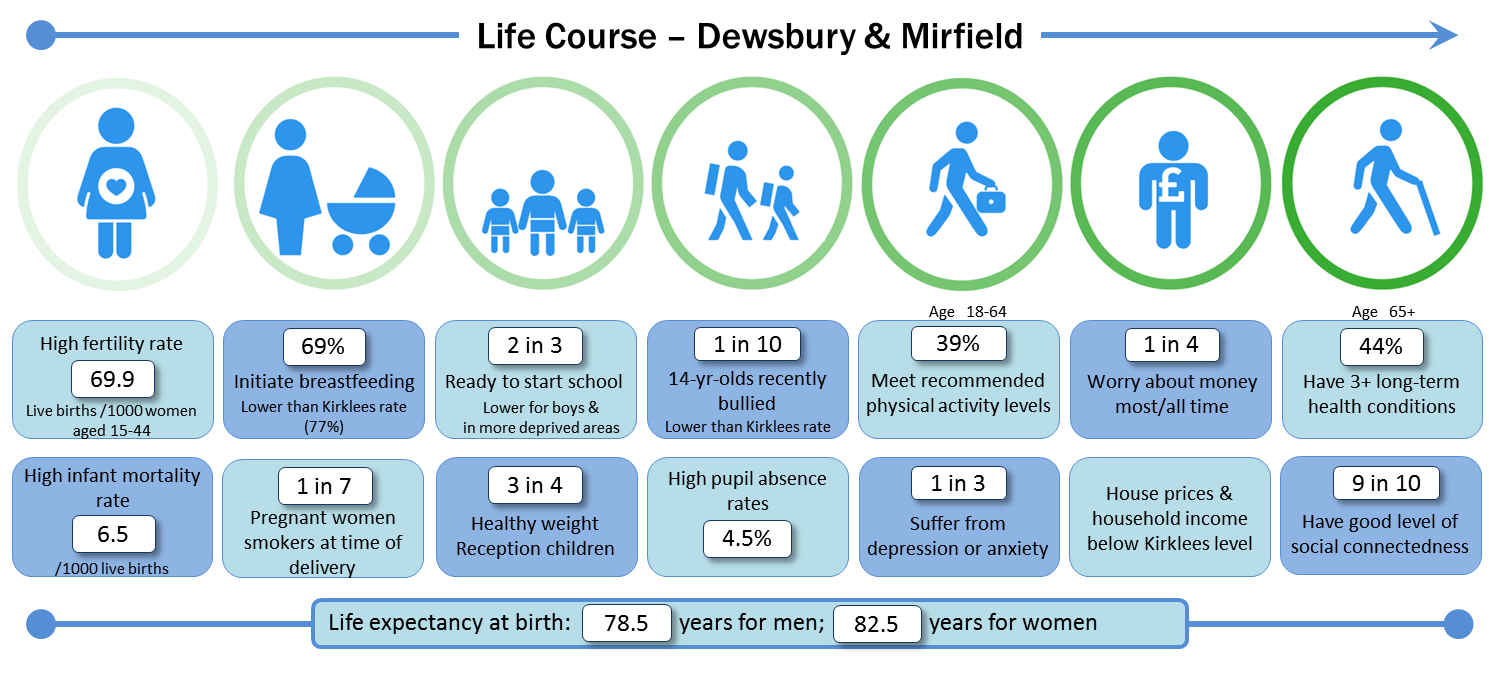
This summary also includes sections on ‘Population’ (including age and ethnicity profiles, population projections, fertility and mortality rates, and life expectancy) and ‘People and place’ (including perceptions of the local area, and wider factors such as air pollution, transport, money and housing).
Population
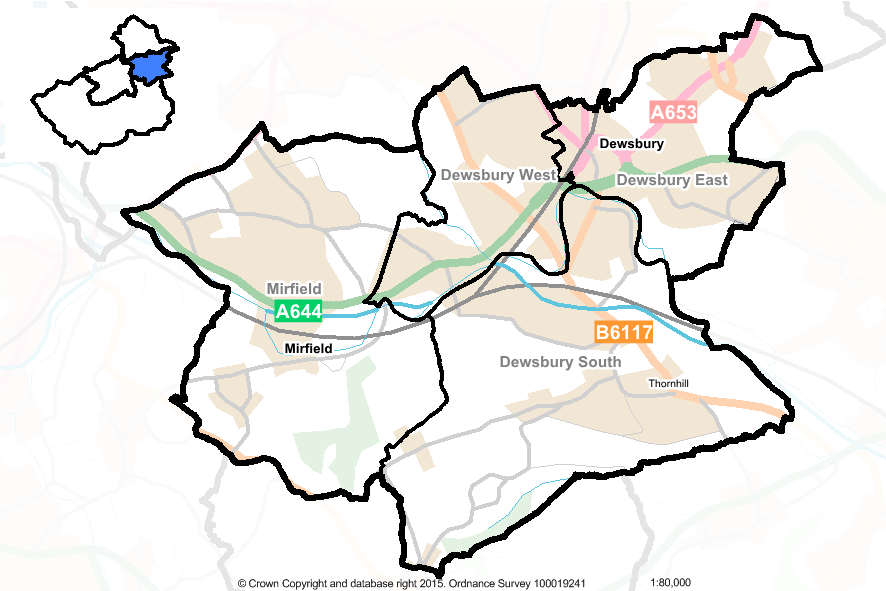
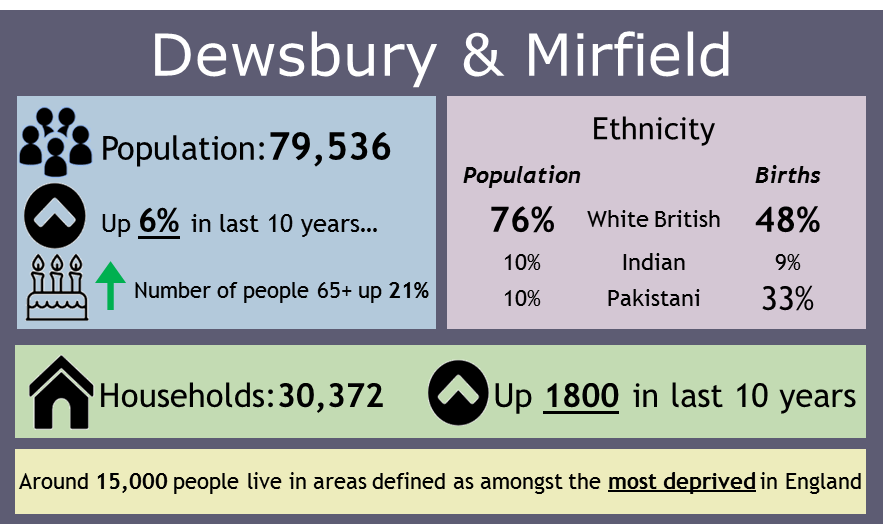
- Dewsbury and Mirfield District Committee includes four political wards: Mirfield, Dewsbury West, Dewsbury East and Dewsbury South.
- The population of Dewsbury and Mirfield is increasing, particularly amongst the middle-to-older age categories. All age categories have seen an increase in population over the past 10 years except for the 30-44 age bracket which has marginally decreased (0.3%). (1) The population density of different age groups across Kirklees is shown in more detail in the population summary.
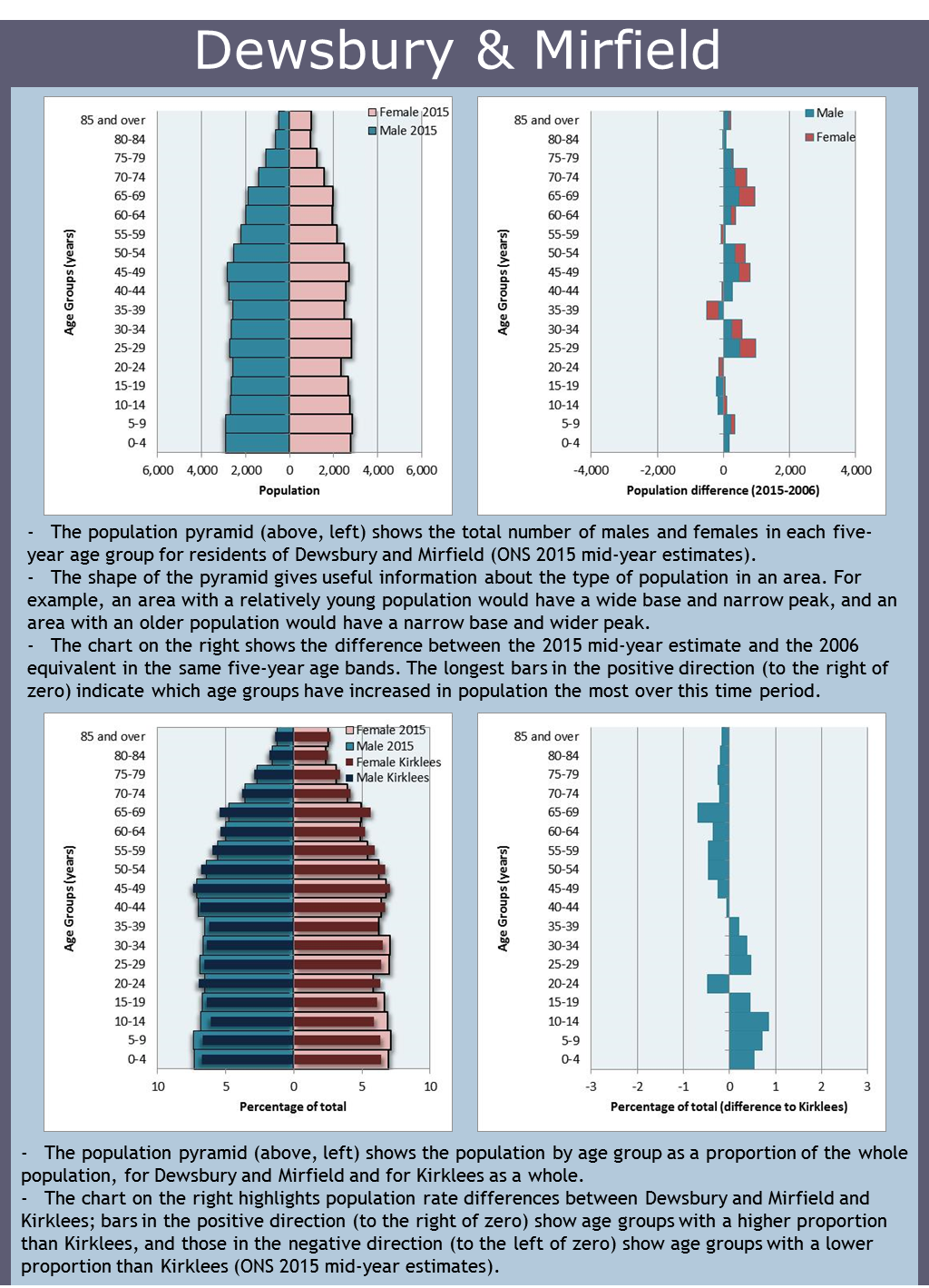
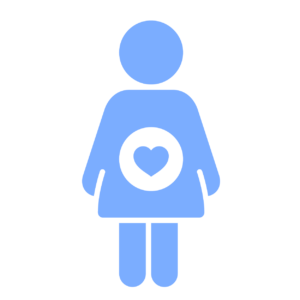
- The general fertility rate (live births per 1000 women aged 15-44) is significantly higher than Kirklees and national averages (69.9 for Dewsbury and Mirfield in 2015 compared with 64.2 for Kirklees and 62.5 for England). (2) (3)
- Although seven in 10 (70%) people living in Dewsbury and Mirfield are from a White background, only around five in 10 (53%) births are in this ethnic category. Higher birth rates in ethnic minority groups suggest that the profile of this area will change in coming years. (4) (5) (6)
- Infant mortality rates (deaths in infants aged under 1 year per 1000 live births) (7) in Dewsbury and Mirfield are above the Kirklees average (but not at a statistically significant level). There has been a long-term decline in infant mortality rates in this area although rates have increased marginally over the past three years. In 2013-15, the infant mortality rate was 6.5 per 1000 in Dewsbury and Mirfield and 5.0 in Kirklees overall, neither being significantly different than the national average of 4.0 deaths per 1000. Infant mortality is linked to smoking in pregnancy, low birth weight and congenital abnormalities (defects that are present at birth).
- The proportion of low birth weight live births in 2015-16 (2.7%) (8) is below the Kirklees average (3.5%) (but not at a statistically significant level).
- Dewsbury East and Mirfield have larger proportions of older age groups whereas Dewsbury West and Dewsbury South have larger proportions of younger age groups. (1)
- Compared to Kirklees overall (79.4 years), male life expectancy at birth in Dewsbury and Mirfield is slightly lower (78.5 years), but female life expectancy is similar (82.5 years vs 82.6 years for Kirklees). Life expectancy at age 65 for both males (83.2 years) and females (85.5 years) in Dewsbury and Mirfield is similar to Kirklees overall (83.4 and 85.6 years respectively). In the last 10 years, male and female life expectancy at birth in Dewsbury and Mirfield have both increased by 3.4 years. (9) (10) (11)
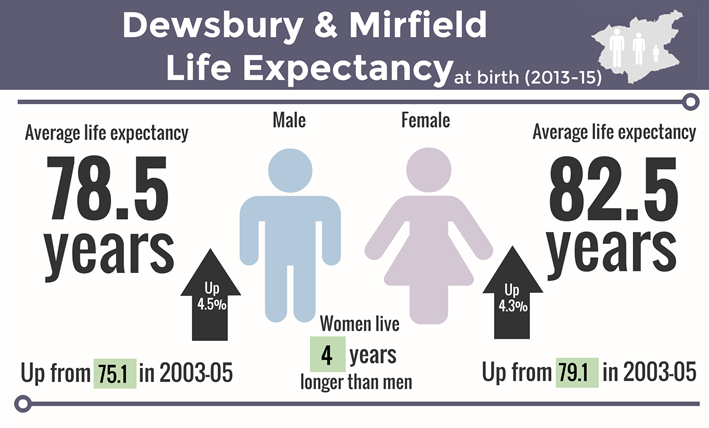
Starting well
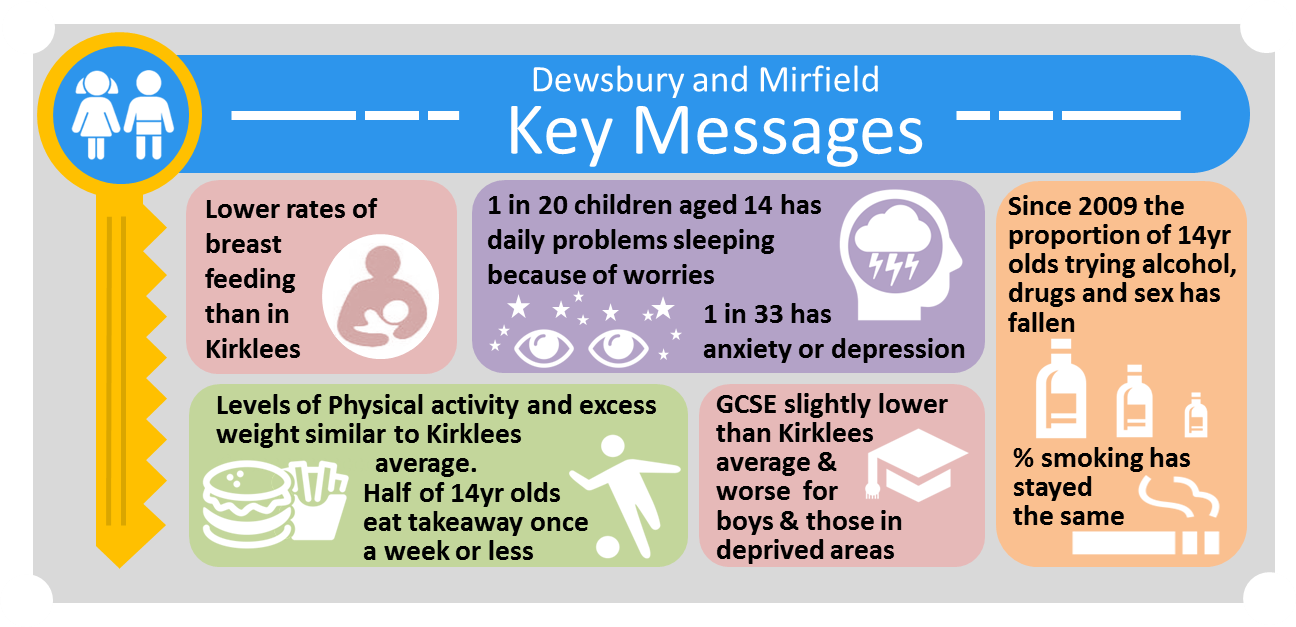
A key outcome for Kirklees is ensuring every child has the best start in life. Our aim is to enable all children and young people to maximise their capabilities and have control over their lives.
Many factors contribute to improving and maintaining the health and emotional wellbeing of a child, from their mother’s health pre-conception and through pregnancy, to their home and local environments and the support of local communities and schools. In this section, we look at some of the key indicators for the children of Dewsbury and Mirfield.
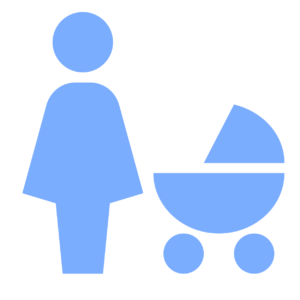
- Compared to Kirklees as a whole, new mothers in Dewsbury and Mirfield have consistently lower rates of starting breastfeeding (69% vs 77% in Kirklees) and breastfeeding at 6-8 weeks after delivery (37% vs 45%). (12) (13) (14)
- Smoking rates amongst pregnant women, at time of delivery, in Dewsbury and Mirfield are similar to the Kirklees average (14% in Dewsbury and Mirfield and 13% in Kirklees). Smoking in pregnancy is a key risk factor for low birth weight and, later, childhood asthma. (15) (16)

Developing well
- The proportion of reception pupils achieving a good level of development (GLD) in Dewsbury and Mirfield is similar to Kirklees overall (67% and 68% respectively). However, the proportion of pupils who are ‘free school meal eligible’ achieving a GLD is much lower than this (52% for Dewbury and Mirfield and 51% for Kirklees).
- There are inequalities in GLD in Dewsbury and Mirfield between boys (59%) and girls (76%), a similar pattern to Kirklees as a whole. In Dewsbury and Mirfield and across Kirklees this indicator also demonstrates inequalities between ethnic groups and between the most and least deprived areas (61% and 77% respectively).(17)


- Emotional wellbeing in 14 year olds (school years 9 and 10) does not differ significantly between District Committee areas.(18)
- A new baseline measure for resilience in children and young people was established in 2015 (19). This shows that on average children and young people in Kirklees have good-to-average levels of resilience. Resilience levels were the same on average in Dewsbury and Mirfield as they were in the other District Committees and in Kirklees overall. Whilst this is positive there is scope to improve this further. (18)
- One in 20 (5%) 14 year olds had daily problems getting to sleep because of being anxious or worried. This was the same as for Kirklees overall. This has reduced slightly from one in 17 (6%) in 2009. The rate was slightly higher in girls (6%) than boys (4%) and slightly higher in the most deprived areas than the least deprived areas. (18)
- One in 33 (3%) of 14 year olds said they had anxiety or depression in 2014. This was the same as for Kirklees overall and there was little variation across the borough. (18)
- In Dewsbury and Mirfield, one in ten (10%) 14 year olds (school years 9 and 10) said they had been bullied once a week or more in the last two months, the same as Kirklees overall. These figures have reduced significantly from almost one in four (23%) for Dewsbury and Mirfield and one in five (20%) in Kirklees in 2009. (18)

Food, obesity and physical activity
- The proportion of healthy weight 4-5 year-old children in Dewsbury and Mirfield is similar to the Kirklees average (76% vs 77% for Kirklees). The proportion of healthy weight 10-11 year-olds is the same as the Kirklees average (62%).(20)
- Just over half (52%) of young people (aged 11-18 years) in Dewsbury and Mirfield eat takeaway meals less than once a week or never which is lower than Kirklees overall (64%). (18)
- Just over half (53%) of 14 year olds in Dewsbury and Mirfield have breakfast every day before school, while one in seven (14%) never eat breakfast before school, both similar to Kirklees overall (50% and 14%). (18)
- One in five (20%) 14 year olds in Dewsbury and Mirfield eat five or more portions of fruit or vegetables a day.(18)
- Only one in six (17%) 14 year olds met the recommended level of 60 minutes of physical activity per day, similar to Kirklees overall (18%). One in five (19%) did not take part in any regular exercise, also similar to Kirklees overall (21%). (18)
- One in seven (14%) 14 year olds in Dewsbury and Mirfield said they had a health problem or disability in 2014, slightly higher than Kirklees overall (13%). This has increased from one in 10 (10%) in 2009. (18)
- One in 13 (8%) 14 year olds in Dewsbury and Mirfield said they had asthma, which is similar to Kirklees overall (7%). Asthma rates were higher in the most deprived areas and slightly higher in girls (9%) than boys (7%) overall. (18)
- Teenage conception rates in Dewsbury and Mirfield (2012-14) are similar to Kirklees overall (26.9 vs 27.1 per 1000) and slightly higher than the national average (25.1) but the rates are declining across the district. (21)
- Most 14 year olds (school years 9 and 10) in Dewsbury and Mirfield have not had sex (88%) which is slightly lower than the 2009 figures (90%). In Kirklees as a whole, the proportion of 14 year olds who have not had sex has remained the same since 2009 (87%). Of those who have had sex, one in three (39%) said they always used a condom. This is similar to Kirklees overall (40%) but has reduced from 57% in 2009. There were no significant inequalities between males and females or between the more and less deprived areas. (18)


Tobacco, alcohol and drug misuse
- In 2014 one in three (36%) of 14 year olds (school years 9 and 10) in Dewsbury and Mirfield said they had tried alcohol, which is much lower than in 2009 (60%). For Kirklees overall there is a downward trend (51% in 2014 vs 66% in 2009). There was a significant difference between the proportion of 14 year olds in the least deprived areas (38%) and the most deprived areas (66%) who had tried alcohol but there was no significant difference between males (52%) and females (57%). (18)
- In Dewsbury and Mirfield, the proportion of 14 year olds drinking weekly or more reduced from 17% in 2009 to 5% in 2014. This was a similar for Kirklees overall which showed a significant reduction from 22% in 2009 to 10% in 2014. (18)
- One in 25 (4%), of 14 year olds in Dewsbury and Mirfield smoke regularly which is similar to 2009 and is slightly lower than Kirklees overall (5%). One in three (39%) 14 year olds live with an adult who smokes which is a slight reduction from 45% in 2009 and is higher than Kirklees overall (34%). A similar proportion of 14 year olds in Dewsbury and Mirfield (10%) report using e-cigarettes compared with Kirklees overall (10%). This indicator provides a new baseline for future analyses. (18)
- One in 50 (2%) 14 year olds in Dewsbury & Mirfield reported they had tried drugs, a reduction from 8% in 2009. A similar reduction has taken place in Kirklees as a whole (9% in 2014 vs 12% in 2009). There was some difference between the proportion of 14 year olds in the least deprived areas (6%) and the most deprived areas (12%) who had tried drugs but this was not statistically significant. (18)
- Cannabis was the most commonly used drug with 5% of 14 year olds in Dewsbury and Mirfield who had ever tried drugs and 7% of those in Kirklees overall having tried it. In Dewsbury and Mirfield the vast majority (95%) of 14 year olds have never tried cannabis similar to Kirklees overall (93%). (18)
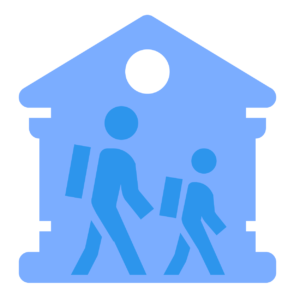
Educational attainment
- Overall, GCSE attainment (five or more A*-C grades in GCSEs including English and maths) was slightly lower for pupils living in Dewsbury and Mirfield (53%) than for Kirklees overall (57%) in 2015/16. There is a significant gender inequality in Dewsbury and Mirfield, with higher levels of attainment in females (58%) than males (48%); this pattern is repeated across Kirklees. Significant inequalities also exist across Kirkless between pupils living in the least and most deprived areas (74% and 43%, respectively). (22)
- Pupil absence in Dewsbury and Mirfield is significantly higher than Kirklees overall (48 vs 43 absence sessions per 1000 possible sessions). (23)
- In 2016, the amount of NEET young people (those aged 16 to 18 not in full time education, training or employment) in Dewsbury and Mirfield was 3% which was highter than Kirklees overall (2.5%) but lower than the national average (6.5%). (24)
A young carer is a person aged between eight and 18 years who provides unpaid care to somebody because of a physical disability; mental ill health; sensory impairment; substance misuse; long-term condition; learning disability or illness.
- In 2014, 8% of Kirklees pupils identified themselves as carers of a parent, relative, brother or sister. (18)
- One in 10 (10%) 14 year olds in Dewsbury and Mirfield said that they were a carer for a family member. This compares with one in 13 (8%) in Kirklees overall where 2% cared for a parent with an illness; 3% for a sibling with an illness; and 2% for another relative. (18)
Living well
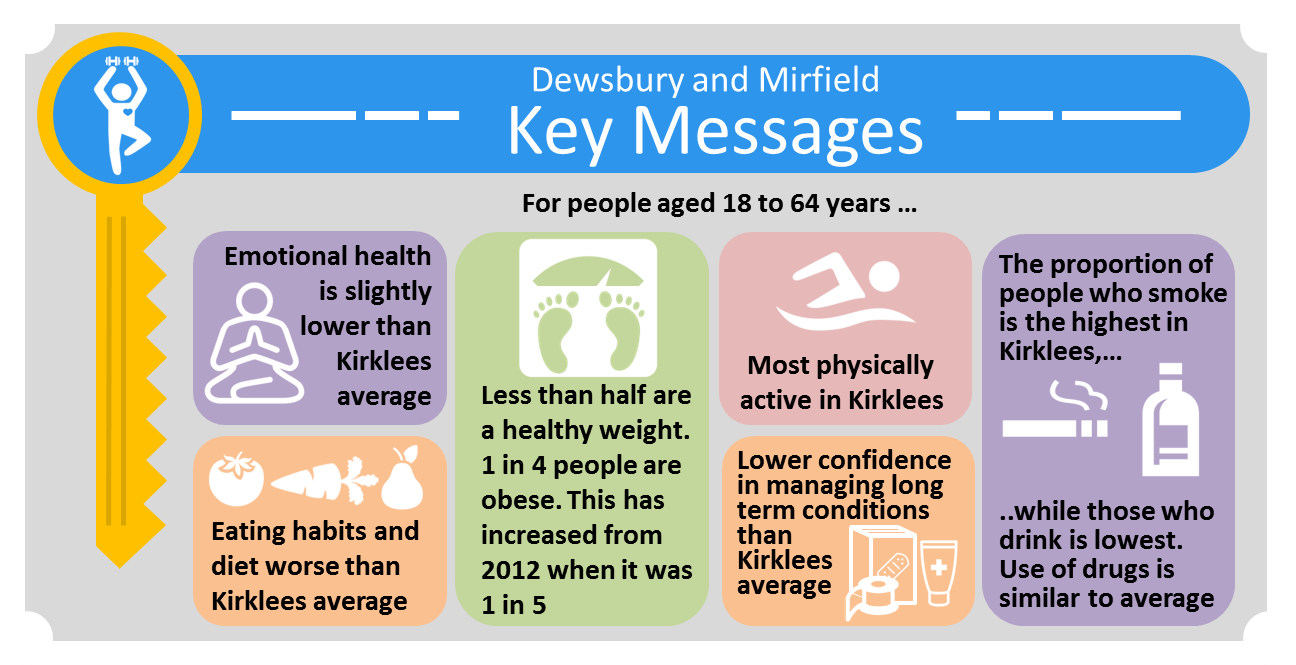
This stage of the life course spans the ages 18 to 64, and covers more than 60% of the population of Kirklees. Although many people are continuing to work to an older age before retiring, for convenience we are also referring to this age group as ‘working age’.
Many of the lifestyle choices and health behaviours of people in this age group will have a direct impact on their health and emotional wellbeing, potentially limiting their ability to work and live their life to the full. Enabling people to adopt a healthier lifestyle during this phase of life alongside addressing the wider determinants of health such as income, employment and housing can improve health and quality of life in older age.


Emotional health and wellbeing
- Emotional wellbeing of the working age population (measured using the SWEMWBS tool) (25) is slightly lower than in Kirklees overall (but not statistically significantly different).This score is highest amongst those aged between 25 and 34 years and lowest in those aged between 18 and 24 years. (26)
- Over one in three (35%) working age adults report having mental health problems such as depression or anxiety, which is the same as the Kirklees average. This proportion has increased in Dewsbury and Mirfield from one in four (23%) in 2012. (26)

Food, obesity and physical health
- Amongst working age adults and women of childbearing age in Dewsbury and Mirfield, cooking confidence and cooking frequency are slightly lower than the Kirklees average. In addition, both these groups are less likely to eat the recommended number of portions of fruit and vegetables than the Kirklees average. For adults in Dewsbury and Mirfield, 64% were quite or extremely likely to eat five portions a day, compared to 66% in Kirklees. For women of child bearing age these values were also 64% and 66% respectively. 26)
- Obesity is a risk factor for diabetes, cardiovascular disease (including heart attacks and stroke) and some cancers, so rising levels of obesity are a key concern. Less than half (42%) of the working age population in Dewsbury and Mirfield are a healthy weight. Overweight and obesity levels in Dewsbury and Mirfield are similar to the Kirklees average. The proportion of obese people in Dewsbury and Mirfield has increased (from 21% in 2012) with one in four (25%) working age adults in Dewsbury and Mirfield being obese. The highest rates of obesity are amongst 55-64 year olds of whom almost one in three (31%) is obese. (26)
- Over one in three (39%) working age adults in Dewsbury and Mirfield meet the recommended physical activity levels. This is the highest rate of all district committees in Kirklees. Physical activity is lowest amongst those aged 35-44 years of whom less than one in three (30%) meets the recommended levels. (26)
- Clusters of unhealthy behaviours are an issue of concern across Kirklees. In Dewsbury and Mirfield, one in ten (10%) women of childbearing age has a combination of three unhealthy behaviours (relating to diet, physical activity, smoking, alcohol consumption, or drug use). Combined unhealthy behaviours are least prevalent amongst those aged 25 to 34 years of whom one in 14 (7%) has three or more unhealthy behaviours. This is almost a third of the rate in those aged 35 to 44 years (17%). (26)
Long-term conditions
- One in three (30%) people aged between 18 and 65 years suffer from 3 or more long-term conditions. However, co-morbidity (the existence of more than one disorder or disease at the same time) is strongly associated with age. One in five people (22%) aged 18-44 years (equal across those aged 18-34 years and those 35-44 years) has three or more long-term conditions and this doubles to almost half (47%) of those aged 55-64 years. (26)
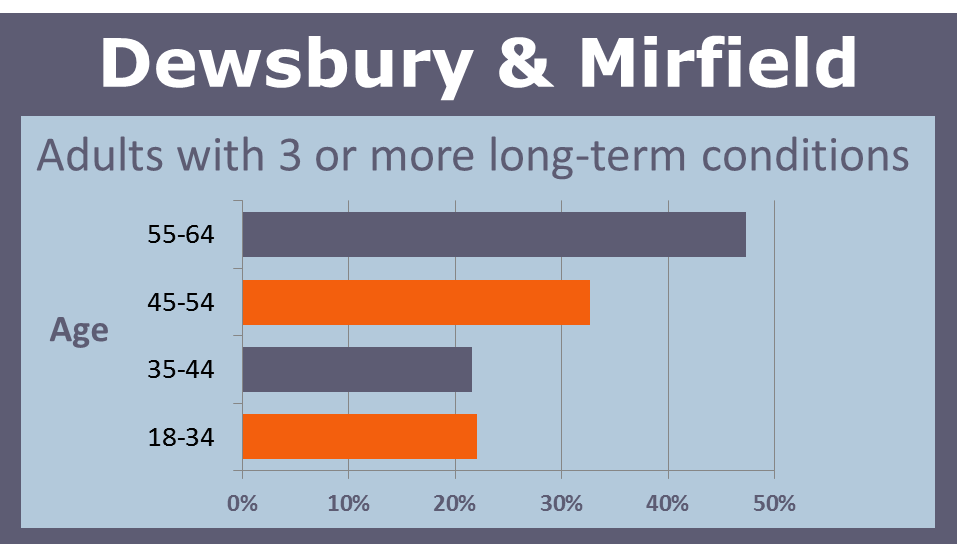
- The prevalence of all long-term conditions amongst adults is very similar to the Kirklees average. The five most common long-term conditions in people aged under 65 years are shown below:
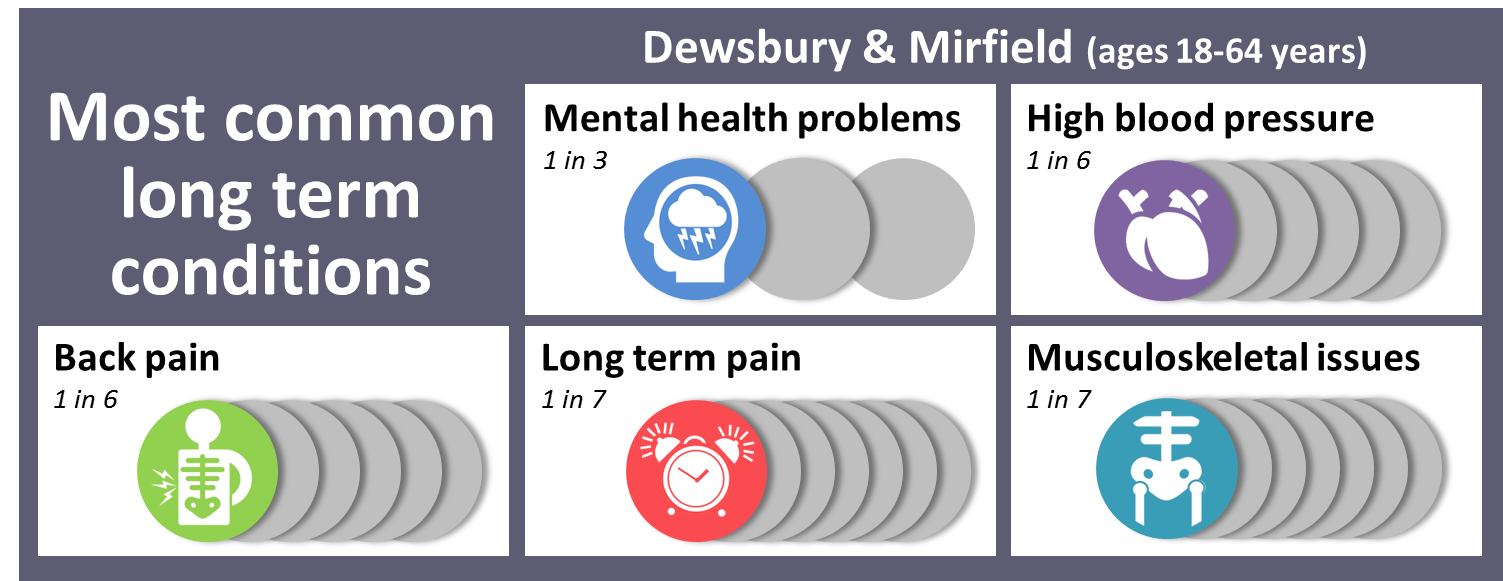
- Mental health problems such as depression or anxiety are experienced by one in three (35%) high blood pressure (one in six (17%)), backache (one in six (16%)), long term pain (one in seven (15%)) and musculoskeletal issues (one in seven (15%)).(26)
- Seven out of ten (70%) adults aged under 65 years with a long-term condition say they feel confident that they can manage their conditions. This is lower in Dewsbury and Mirfield than Kirklees overall (75%). (26)
- The self-reported diabetes rates in adults aged under 65 years is higher in Dewsbury and Mirfield than the Kirklees average (9% and 7% respectively). People of South Asian ethnicity in this age group are twice as likely to have diabetes than those of white ethnicity (15% vs 7%, respectively). (26)
- Overall mortality rates in people aged below 75 years are not significantly different from the Kirklees average and are highest for cancer (140.0 per 100,000). Compared with Kirklees overall, mortality rates in Dewsbury and Mirfield are slightly higher for all circulatory diseases (87.8 vs 79.2 per 100,000), liver disease (21.2 vs 18.6 per 100,000) and respiratory diseases (54.7 vs 37.5 per 100,000). The under-75 mortality rate from suicide is slightly lower than the Kirklees rates (5.4 vs 8.9 per 100,000). (9)


- One in six (18%) of working age adults regularly smoke, the highest proportion of the four Kirklees district committees, but a slight decrease from one in five (20%) adults in 2012. Smoking rates are higher in more deprived areas and they are highest in Dewsbury West (24%) and lowest in Mirfield (12%), a difference which is statistically significant. (26)
- Only one in 14 (7%) adults under 65 years use e-cigarettes. The most common reason for using e-cigarettes is because it is healthier than traditional smoking (44%). Other common reasons are to cut down on tobacco use (31%), to aid in giving up smoking altogether (30%) and because it is cheaper than regular cigarettes (28%).
- The proportion of people who drink alcohol in Dewsbury and Mirfield is the lowest in Kirklees (63% vs 74% for Kirklees overall). Both figures have fallen slightly since 2012. For those who drink alcohol, the rate of excess weekly alcohol consumption increases with age. Almost one in three 45 to 54 year olds (29%) drink over the recommended limit of 14 units a week compared with just one in ten (10%) 18 to 24 year olds. (26)
- Self-reported use of illegal or recreational drugs in the last five years is similar between Dewsbury and Mirfield and Kirklees overall (10% and 9% respectively). Use of illegal substances decreases with age, being highest in those aged 18-24 (one in five, 21%). The most commonly reported drug used is cannabis (75% of self-reported users). The rate of heroin use in Dewsbury and Mirfield is double that in Kirklees (6% vs 3%). (26)
Working well
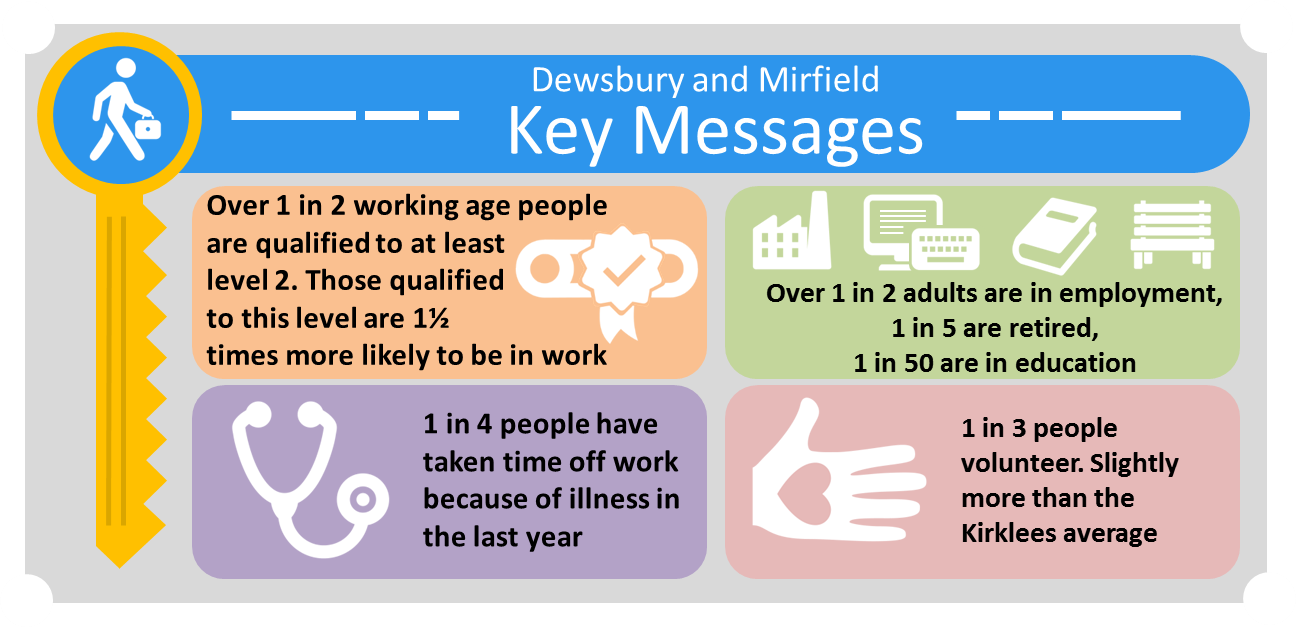
Two key outcomes for Kirklees are that people have aspiration and achieve their ambitions through education, training and lifelong learning and that Kirklees has sustainable economic growth and provides good employment. The benefits to health and emotional wellbeing of good quality employment are well documented. This section highlights those indicators contributing to ‘working well’ in Dewsbury and Mirfield.

- Over half (57%) of working age adults are qualified to at least level 2 (lower than the district as a whole (67%)). Both figures have fallen since 2012 (from 64% for Dewsbury and Mirfield and from 72% for Kirklees).Those who are qualified to level 2 or above are one and a half times more likely to be in employment than those not qualified to this level (76% vs 53% respectively). However, the employment rate for working age adults qualified to level 2 or above is lower in Dewsbury and Mirfield than in the other district committee areas.(26)
- Around 2% of the working age population are claiming Jobseekers Allowance in Dewsbury and Mirfield, the same as Kirklees overall. This is at its lowest level since the end of 2015 and has remained fairly static (27).
- Over half of the adult population is in employment (54%), with a further one in five people being retired (22%) and one in 50 in education (2%). (26)
- Around a quarter of working adults (27%) in Dewsbury and Mirfield have experienced an illness in the last 12 months which required them to take time off work. Of those experiencing an illness, over two in three (70%) reported that it resulted in a work absence of over two months. (26)
- Levels of volunteering are slightly higher in Dewsbury and Mirfield compared to Kirklees as a whole. In Dewsbury and Mirfield one in three people (30%) give unpaid help to a group, club or organisation at least once a month. Volunteering is highest amongst those aged 35 to 44 years (33%). The most commonly provided types of volunteering are visiting people (11%) and organising or running events (8%).(26)
Ageing well
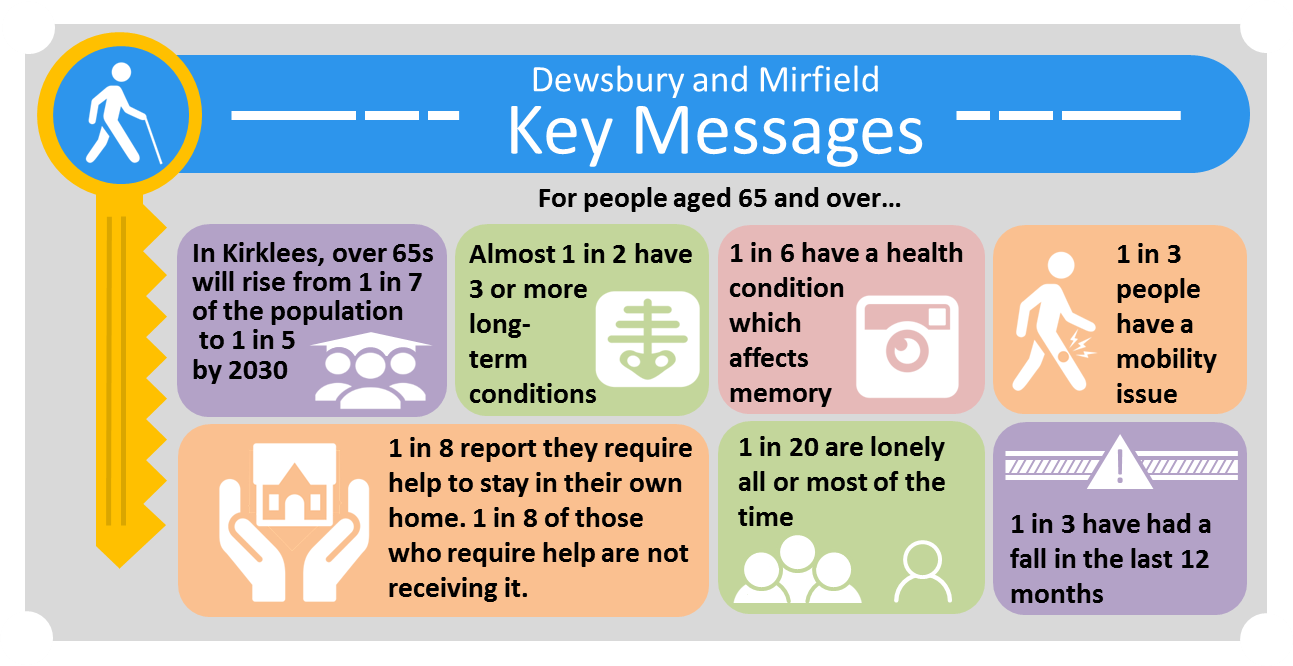
The prevalence of common long-term conditions (e.g. heart disease, hypertension, stroke, respiratory disease, diabetes) increases as people get older, along with other health issues such as visual impairment and physical disabilities. These factors have a significant impact on people’s independence and need for care and support. Prevention and early intervention is therefore vital to enable people be as well as possible for as long as possible, live independently and have control over their lives.
The number and proportion of people aged 65 years and over in Kirklees is projected to rise, from around one in seven people (16%) in 2015 to one in five people (21%) by 2030 (an increase of around 34,000 people).


Emotional health and wellbeing
Older people appear to have higher emotional wellbeing than those of younger age groups. In Dewsbury and Mirfield those aged 65 and over have significantly higher emotional wellbeing than adults aged 18-64 (based on SWEMWBS scores). SWEMWBS scores are slightly lower in Dewsbury and Mirfield than Kirklees for those aged 65 years and over. (26)
Long-term conditions
- The prevalence of long-term conditions increases with age and co-morbidity (the existence of more than one disorder or disease at the same time) is most common amongst the older age groups. In Dewsbury and Mirfield, over two in five (44%) people aged 65 years or over suffer from three or more long-term health conditions, compared with less than one in three (30%) of those aged 18-64 years. Problems with mobility and self-care also increase with age. One in three (35%) people in Dewsbury and Mirfield aged over 65 years has moderate to extreme problems with mobility and almost one in ten (9%) has moderate to extreme problems with self-care. Both of these values are slightly above the Kirklees average (31% and 8%, respectively). (26)
- The most common long-term conditions reported by those aged 65 years and over are shown below:
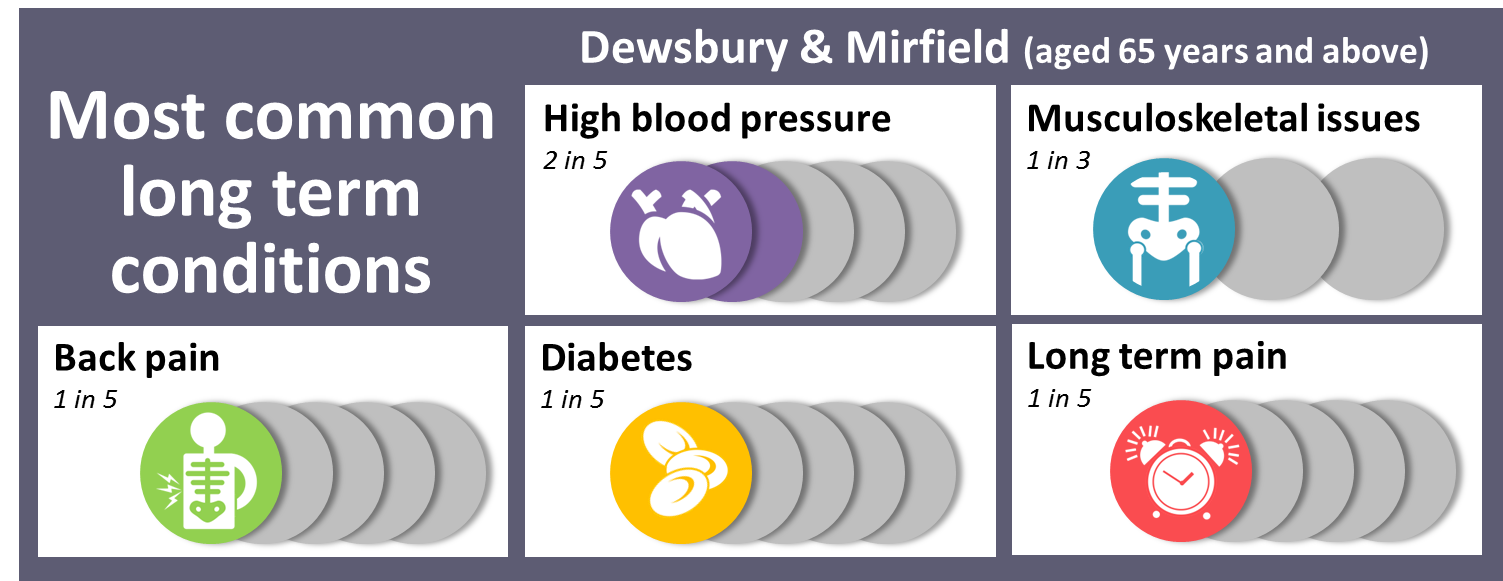
- The five most common conditions are high blood pressure (two in five, 43%); musculoskeletal issues (one in three, 36%); back pain (one in five, 22%) and diabetes (one in five, 22%) and long term pain (one in five, 20%). The prevalence of self-reported chronic disease also increases with age – comparing those aged 65 years and over with those aged 18-64 years, heart disease is seven times more likely (14% vs 2%, respectively); cancer is between four and five times more likely (9% vs 2%, respectively) and Chronic Obstructive Pulmonary Disease (COPD) is three times more likely (10% vs 3%, respectively). (26)
- One in six people (18%) aged 65 years and over report having some health condition which affects their memory. (26)


- Around one in ten (9%) of those aged 65 years and over are regular smokers, compared with one in six (18%) of those aged 18-64 years. Those aged 65-74 years are more likely to smoke than those aged 75 or over (10% vs 6%). (26)
- In Dewsbury and Mirfield, the use of e-cigarettes by people aged 65 years and over is less common than in those aged under 65 (7% vs 3%), however, it is similar to the Kirklees average (4%). (26)
- Adults aged 65 years and over in Dewsbury and Mirfield are more likely to drink alcohol than those under the age of 65 (72% vs 63%, respectively). The proportion drinking above the recommended limit (14 units per week) is almost twice as high in those aged 65-74 years than in those aged 75 years or above (29% vs 16%, respectively). (26)
- Use of illegal substances is very low in the over 65 years age group, with only one in 100 survey respondents (1%) saying they had used drugs in the last five years. (26)
Remaining healthy, active and independent
- Almost two in three (65%) people aged 65 years and over are above their healthy weight, with almost one in four (26%) being obese. These values are slightly above the corresponding rates for Kirklees (62% and 21% respectively). (26)
- Just over a third (37%) of people aged 65 years and over undertake 150 minutes of moderate physical activity per week, which is similar to the Kirklees average for this age group (39%). (26)
- One third (35%) of people aged 65 years and over have moderate to severe issues with their mobility and one in four (25%) with typical daily activities (e.g. work, study, housework, family or leisure activities). One in ten have problems with self-care (9%). (26)
- One in eight (12%) people aged 65 years and over reports that they require some assistance to remain living within their own home. This value is slightly below the Kirklees average (14%), although Dewsbury and Mirfield has a higher rate of unmet need. Of those who do require help, one in eight (12%) do not receive it from family, friends or professional care workers in Dewsbury and Mirfield, compared to one in 11 in Kirklees overall (9%). (26)
- Over half (57%) of people aged 65 years and over report feeling lonely at least some of the time with around one in 20 (5%) reporting they feel lonely all or most of the time. These values are lower than for those under 65 years of age in Dewsbury and Mirfield (64% of those aged 18-64 years feel lonely at least some of the time and 10% all or most of the time). Nine in ten (92%) people aged 65 years and over in Dewsbury and Mirfield have good ‘social connectedness’ (they have someone they can count on to comfort them when they are upset or they have someone they can count on to help them out in a crisis). This is similar to the Kirklees average (91%)). (26)
- One in three (29%) people aged 65 years and over has fallen and hurt themselves in the last 12 months, with one in six (18%) of these falls resulting in a broken bone. The proportion of falls resulting in a broken bone is lower in Dewsbury and Mirfield than the Kirklees average (28%). (26)
People and place
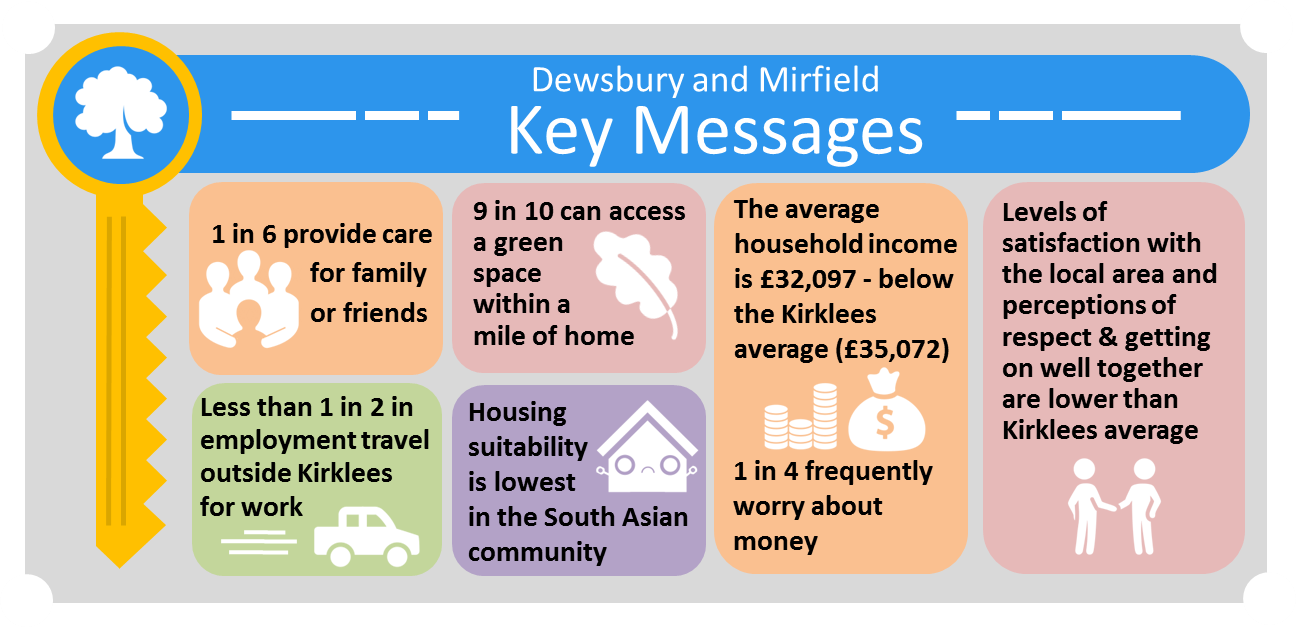
An individual’s health, emotional wellbeing and quality of life may be improved or adversely affected by their perceptions of, and interactions with, their local area, as well as wider factors such as transport, air quality, finances and housing.
Kirklees partner organisations therefore want people in Kirklees to live in cohesive communities, feel safe, be safe and protected from harm. They also want people to experience a high quality, clean, sustainable and green environment and for Kirklees to have sustainable economic growth and provide good employment.
- One in six (17%) adults in Dewsbury and Mirfield provide some sort of care for family, friends or neighbours in a voluntary capacity. This is the same across the age groups, although a higher proportion of older people provide round-the-clock care (4% of those aged 65 years and over vs 1% of those aged 18-64 years). (26)
- Carers providing high levels of care are twice as likely to suffer from ill health as non-carers (28).
The local area
- More than nine in ten (94%) people in Dewsbury and Mirfield have access to green spaces within a mile of their home, although only around two in three (66%) of those with access utilise the space at least once a month. Usage is lowest in the most deprived areas (58%) and highest in the least deprived areas (69%). (26)
- The proportion of people satisfied with their local area as a place to live is lower in Dewsbury and Mirfield (66%) than in Kirklees overall (79%). Satisfaction levels increase with age, rising from one in two (48%) in those aged 18-24 years to four in five (81%) in those aged over 75 years. (26)
- Two in five (41%) working people in Dewsbury and Mirfield travel outside of Kirklees for work, the same as the Kirklees average. The most common location of work outside of Kirklees is Leeds (12%). (26)
- Around two in five (38%) people report using walking as a method of travel, similar to the Kirklees average (39%). One in 30 (3%) use bicycles for travel, similar to Kirklees overall (4%). Walking and cycling were more popular as recreational or leisure activities in Dewsbury and Mirfield (51% walking for leisure and 8% cycling for leisure). (26)


Air quality
Air pollution is associated with a number of adverse health impacts. It is recognised as a contributing factor in the onset of heart disease and cancer and is linked to asthma, stroke, diabetes, low birth weights and dementia. Additionally, air pollution particularly affects the most vulnerable in society: children and older people, and those with heart and lung conditions. There is also an important inequality dimension because areas with poor air quality are also often the less affluent areas.
The annual health cost to society of the impacts of particulate matter alone in the UK is estimated to be around £16 billion (29).
The air quality issues within Kirklees are focussed around the road network connecting the towns, and traffic which passes between the West Yorkshire conurbation along the M62 and Greater Manchester.
Kirklees Council have conducted monitoring across the district where these primary roads are in close proximity to relevant human activity. To date Kirklees has identified two primary pollutants of concern. They are Nitrogen Dioxide (NO2) and Particulate Matter (PM).
Current trends indicate that the levels of these pollutants have fallen over the last 5 years, but the UK Air Quality Objectives (AQO) are still exceeded within some areas in Kirklees. In 2015, NO2 levels at 8 out 11 air quality monitoring sites in Dewsbury and Mirfield exceeded the AQO, compared to 30 exceedance sites in 2010 and 23 sites in 2014.
Dewsbury also has an Air Quality Management Area declared as a result of Particulate Matter exceedance. In 2014 and 2015 improvement actions were conducted that have reduced the levels significantly and now the levels are compliant with health-related objectives. The table here lists improvement projects relevant to the Dewsbury and Mirfield area.

Money
- The average gross household income in Dewsbury and Mirfield is £32,097 which is £2,975 below the Kirklees average. Household income has remained fairly stable over the last five years. (30)
- Around one in four (25%) adults say they have worried about money all or almost all of the time in the past few weeks. This proportion is slightly higher than the Kirklees average (22%). Despite mean household income having fallen slightly since 2012 (when it was £32,493 in Dewsbury and Mirfield), money worries have also fallen (28% in 2012). Frequent money worries are more common in deprived areas and in younger adults. Money worries are also associated with housing tenure. People who rent their home are more likely to worry about money all or most of the time (35%) compared to those with a mortgage (25%) or who own their house outright (12%). (26)
- Almost nine in ten people (86%) are somewhat or very confident in their own ability to budget and pay bills on time. Confidence is higher in those who are employed compared to those who do not work. (26)
- In 2014 there were 113 per 1000 households in fuel poverty in Dewsbury and Mirfield, compared with 116 per 1000 in Kirklees overall and 106 per 1000 nationally. In Dewsbury and Mirfield, fuel poverty rates were highest in Dewsbury West (134 per 1000) and lowest in Mirfield ward (92 per 1000). (26)

- The median [1] house price in Dewsbury and Mirfield in 2015 was £127,500. This is slightly lower than the Kirklees median of £130,000. The median house price in Mirfield (£150,000) is higher than that in Dewsbury East (£119,995), Dewsbury South (£114,500) and Dewsbury West (£112,973).(31)
[1] The median is the middle value in a series of values arranged from smallest to largest
- Most adults consider their home to be suitable for their needs, however, one in eight (13%) believe it to be unsuitable. Perceived housing suitability is lower in the South Asian community, where one in five (19%) consider their housing unsuitable for their needs. The most common reasons for housing not being suitable are that it is too small (52% of those reporting unsuitability), it is damp or cold (16%) and it does not accommodate mobility needs (16%). Perceived housing suitability is lowest in Dewsbury West (79%) and highest in Mirfield (95%). This difference is statistically significant. (26)
- The prevalence of overcrowded housing is higher than Kirklees average (10% in Dewsbury and Mirfield vs 7% in Kirklees overall). Overcrowding is more common amongst young adult householders and more deprived groups. Overcrowding is eight times more likely in the South Asian community than those of white ethnicity (30% vs 4%). (26)


- A summary of reported crime statistics for Dewsbury and Mirfield can be found in this Kirklees Observatory profile: https://observatory.kirklees.gov.uk/crime-and-community-safety/
- Most (82%) 14 year olds feel safe when at school. This is the same as the Kirklees average, but a reduction from the 2009 figure (89% in Dewsbury and Mirfield).(18) Most (75%) 14 year olds feel safe when they are in the community, very similar to 2009 (76%) and to Kirklees overall (75%). Most (59%) 14 year olds also feel safe on public transport but this is lower than Kirklees overall (71%) and lower than in 2009 (71%). (18)
- In Dewsbury and Mirfield in 2014, over half (53%) of 14 year olds said that people of different ages get on well together.(18)
- One in two (53%) of adults in Dewsbury and Mirfield agree their local area is a place where people treat each other with respect and consideration, the lowest rate in Kirklees. This is higher (63%) amongst those of South Asian ethnicity. The rate is highest in Mirfield (67%) which is significantly higher than it is in Dewsbury West, the lowest (45%). (26)
- Two in three (67%) South Asian adults agree their local area is a place where people from different ethnic backgrounds get on well together, compared to one in three (37%) of white adults. Both figures are below the Kirklees average but have increased since 2012. (26)
- The proportion of people who agree their local area is a place where people pull together to improve things is lower in Dewsbury and Mirfield (30%) than in Kirklees as a whole (39%). This is lower in more deprived communities and higher in less deprived communities. (26)
Assets

Health assets are those things that enhance the ability of individuals, communities and populations to maintain and sustain health and well-being. These include things like skills, capacity, knowledge, networks and connections, the effectiveness of groups and organisations and local physical and economic resources.
Assets are hugely important to how we feel about ourselves, the strength of our social and community connections and how these shape our health and wellbeing.
As part of our KJSA development we are piloting a range of methods to capture and understand the assets that are active in Kirklees. Please see the assets overview section for more information about our approach. We want to understand more about how these assets improve health and wellbeing directly or indirectly by, for example, providing space, support, companionship or guidance around a common interest or need such as mental or emotional health problems. This knowledge will help us understand where the gaps in assets might be and where additional support or investment would benefit local communities.
The community assets in Dewsbury and Mirfield summarised here were identified during a ‘Connecting Colleagues’ event in winter 2016. The assets relate to just a few of the key issues identified in the KJSA and are not the whole picture of assets in Dewsbury and Mirfield. This information will be reviewed and updated on an ongoing basis. Additional local assets are outlined below.
Groups, event and activities
Asset Based Community Development (ABCD) is an approach used by community engagement officers to encourage greater connections between people in communities, and an opportunity for people to be more aware of their local assets. It focuses on raising awareness of the talents and skills people already have. It encourages people to recognise what is good about where they live, think more positively about what is around them and what can be achieved by working collectively together. This approach is developed to encourage sustained community activity which is community led and lasts beyond the engagement officer’s input.
Some examples of the local community groups, networks, activities and events in Dewsbury and Mirfield which are contributing to improved health are:
Dewsbury West
- Health and wellbeing projects, outreach, English classes, youth activities and learning disability drop-in at Ravensthorpe Community Centre.
- A new outreach site for Kirklees College at Dewsbury Moor and Scout Hill Children’s Centre.
- Sports and other activities at Dewsbury Moor Rugby Club.
- Friends of Crow Nest Park.
- Group and activities being planned by Friends of Dewsbury Park Mansion.
- The Big Local in Dewsbury Moor planning to offer activities for young people, worklessness, small grants and local investment of Lottery funds.
Dewsbury South
- A new outreach site for Kirklees College at Thornhill Lees Community Centre.
- Taleem Centre (Savile Town)
- New services for young people and older people being developed by Trojans Rugby Club, Thornhill.
- Kumon Y’All, Savile Town
Dewsbury East
- A community hub providing lots of indoor and outdoor activies at Chickenley Community Centre.
Dewsbury Centre
- Arts/ crafts and social activities at the Howlands Centre.
- Health and wellbeing support at the Connect Housing Thrive Project
- Dewsbury Learning Quarter – Two new centres in Dewsbury town centre will replace the current Dewsbury Centre and Batley School of Art. In partnership with the Leeds City Region Enterprise Partnership (LEP) and Kirklees Council, and as part of the wider North Kirklees Growth Zone (NKGZ) regeneration program, Kirklees College will open the ‘Dewsbury Learning Quarter’ in 2018.
Mirfield
- A new outreach site for Kirklees College and a base for Kirklees Recovery College at Pathways.
- Friends of Mirfield Library
- Thriving over 50s group which meets in Zion Baptist Church.
Schools as community hubs
Schools engage with families and children every day and they have a valuable position within our communities. It is therefore critical that the council, schools and their partners work more closely together as we begin to shape future services.
In Dewsbury and Mirfield, some schools are starting to develop partnership arrangements to achieve improved health outcomes. Thornhill school community hub has now started to co-produce some outcomes which will be achieved through working with and building on existing community assets.

Active Travel
The Kirklees Cycling and Walking Strategic Framework and its associated Delivery Plan will help make cycling and walking more attractive for local journeys, benefiting all sectors of the Dewsbury and Mirfield community and helping to raise awareness and understanding of the benefits of active travel. These documents will also influence other people’s agendas and decision makers in the allocation of resources.
Already in existence is the Spen Valley Greenway (SVG). The SVG greenway uses a disused railway line, running near the River Spen, between the towns of Cleckheaton, Dewsbury and Heckmondwike, eventually leading to Bradford.
What could commissioners/service planners/Councillors consider?

Build on existing community assets
Commissioners, service planners and Councillors should consider local community assets such as those outlined above so that they can support and build on local strengths and also understand where there are gaps and unmet needs in particular places or amongst particular communities.
Work with Schools as Community hubs and other partnerships/services
- Look for opportunities to support the development of schools as community hubs as described above. There are opportunities to use the hubs as a new context for existing work and also to develop new ideas directly with hubs. The hubs are increasingly becoming a focus for the recommissioning of a range of existing services, and provide an infrastructure for sharing intelligence, identifying and responding to local needs.
- All service providers – such as schools, GPs, pharmacies, youth services – whose work has an influence on emotional wellbeing and/or sexual health, are encouraged to work alongside the new sexual health services in Kirklees. These have recently been redesigned, with an increased focus on prevention of poor sexual health, including closer working with schools and more outreach work in communities.
Support improved emotional health and wellbeing:
- Support the local Kirklees suicide prevention action plan by:
- overcoming barriers to men accessing help (which links to good lifelong mental health starting in childhood);
- assessing and treating everyone who presents with depression or anxiety in primary or secondary care with rapid access to support and treatment;
- working with the public and voluntary sector to raise awareness of risk factors linked to suicide.
- Integrate existing mental health services into ‘ordinary’ services away from traditional health settings to reach more men.
- Work to promote workplace wellbeing within all types of organisations. Good quality employment is known to aid recovery and be a protective factor for good mental health.
- Support interventions to tackle social isolation and loneliness for working age adults as this group is more likely to develop mental health problems. (32)
- Promote existing local mental health support groups (listed in the Community Directory (33) to maximise the potential reach across the district.
Support healthy ageing:
- Develop peer support programmes for older people to address social isolation.
- Promote and support local community activities that aim to improve mood and social connectedness amongst older people.
- Promote dementia-friendly communities.
- Promote a positive representation of ageing and older age.
Support initiatives that improve quality of life and of local places and communities
Community cohesion
- Continue to develop community cohesion work in Dewsbury and Mirfield and work with communities to build a clear understanding of community assets.
Housing and money
- Develop strategies to tackle the roots of fuel poverty, specifically boosting household income, improving energy efficiency and reducing energy costs.
- Work to ensure that local residents can access suitable housing, manage their own housing needs effectively and live in homes that are suitable for their needs.
- Work with communities to ensure they are confident and able to manage their own money effectively.
Air quality and active travel
- Whilst the levels of nitrogen dioxide in Dewsbury and Mirfield are reducing, there are no safe levels of air pollution. Partners should continue to work holistically across the district and enable the local community to contribute to improvements in air quality. Examples include replacing short car journeys by walking or cycling. This will encourage physical activity, improve air quality and help to reduce obesity and increase emotional wellbeing.
- Work to address the concerns of pedestrians and cyclists by tackling the perceived and real fears associated with cycling and walking, including reducing traffic volume and speed in line with current evidence.
- Create coherent, safe, high quality cycling and walking networks both on and off road – ensuring that the recommended hierarchy of consideration is applied, i.e. 1) Pedestrians 2) Cyclists before other road users; ensuring that maintenance of these routes is accommodated for.
References and additional resources/links

References
- Office for National Statistics. Ward-level mid-year population estimates [Internet]. 2016. Available from: https://www.ons.gov.uk/peoplepopulationandcommunity/populationandmigration/populationestimates/datasets/wardlevelmidyearpopulationestimatesexperimental
- Office for National Statistics. Birth Summary by District Committee. 2015;
- Office for National Statistics. Birth Summary Table 2015 [Internet]. 2015. Available from: https://www.ons.gov.uk/peoplepopulationandcommunity/birthsdeathsandmarriages/livebirths/datasets/birthsummarytables
- Office for National Statistics. Census data [Internet]. 2011 [cited 2016 Jul 8]. Available from: https://www.ons.gov.uk/census/2011census/2011censusdata
- Calderdale and Huddersfield Foundation Trust & Mid-Yorkshire Hospitals Trust. Maternity Indicators 2014-15. 2015.
- Kirklees Council. Births by ethnicity 2015/16. 2016;
- Office for National Statistics. Infant mortality by District Committee. 2015.
- Kirklees Council. Low birth weight by District Committee. 2016.
- Office for National Statistics. Primary Care Mortality Database 2012-14. 2014.
- West Yorkshire Central Services Agency. Local resident population (GP registrations). 2013;
- The National Centre for Health Outcomes & Development. Life expectancy by DC. 2015.
- Calderdale and Huddersfield Foundation Trust & Mid-Yorkshire Hospitals Trust. Breastfeeding at delivery by ward. 2016.
- Kirklees Council. Infants fully or partially breastfed at 6-8 weeks FQ03 15-16 [Internet]. Available from: http://observatory.kirklees.gov.uk/dataviews/tabular?viewId=532&geoId=145&subsetId=
- Calderdale and Huddersfield Foundation Trust & Mid-Yorkshire Hospitals Trust. Breastfeeding at 6 to 8 weeks. 2016.
- Calderdale and Huddersfield Foundation Trust & Mid-Yorkshire Hospitals Trust. Smoking at delivery. 2016.
- Sharma S, Dubinett S, Salgia R. Maternal Smoking during Pregnancy and Its Effect on Childhood Asthma. Am J Respir Crit Care Med. 2012;186(10):940–1.
- Kirklees Council. Good level of development. 2015.
- Kirklees Council. Children and Young People’s Survey 2014. 2014.
- von Soest T, Mossige S, Stefansen K, Hjemdal O. A Validation Study of the Resilience Scale for Adolescents (READ). J http://dx.doi.org/10.1007/s10862-009-9149-x
- Health and Social Care Information Centre. National Child Measurement Programme 2015-16. 2016.
- Office for National Statistics. Teenage conception data 2012-14. 2014.
- Department for Education. GCSE results 2015-16. 2016.
- Kirklees Council. School census. 2014.
- Kirklees Council. NEET people age 16 to 19 [Internet]. 2015. Available from: http://observatory.kirklees.gov.uk/dataviews/tabular?viewId=532&geoId=145&subsetId=
- Tennant R, Hiller L, Fishwick R, Platt S, Joseph S, Weich S, et al. The Warwick-Edinburgh Mental Well-being Scale (WEMWBS): development and UK validation. Health Qual Life Outcomes [Internet]. 2007;5:63. Available from: http://www.pubmedcentral.nih.gov/articlerender.fcgi?artid=2222612&tool=pmcentrez&rendertype=abstract
- Kirklees Council;, NHS Greater Huddersfield CCG;, NHS North Kirklees CCG. Current Living in Kirklees Survey 2016. 2016.
- Kirklees Council Observatory. Unemployment Quick Look Profile [Internet]. 2016. Available from: http://observatory.kirklees.gov.uk/profiles/profile?profileId=124
- Department of Health. Our Health and Wellbeing Today. 2010.
- Department for Environment Food & Rural Affairs (Defra). Air Quality: Economic Analysis [Internet]. Gov.uk – Guidance. 2015. Available from: https://www.gov.uk/guidance/air-quality-economic-analysis
- Kirklees Council. Mean gross household income profiles [Internet]. 2016. Available from: http://observatory.kirklees.gov.uk/profiles/profile?profileId=133
- Kirklees Council. Kirklees Strategic Housing Market Assessment 2015. 2015;(06205180). Available from: http://www.kirklees.gov.uk/beta/planning-policy/pdf/strategic-housing-market-assessment.pdf
- Pulkki-Råback L, Kivimäki M, Ahola K, Joutsenniemi K, Elovainio M, Rossi H, et al. Living alone and antidepressant medication use: a prospective study in a working-age population. BMC Public Health [Internet]. 2012;12(1):236. Available from: http://dx.doi.org/10.1186/1471-2458-12-236
- Kirklees Council. Community Directory – Mental health resources [Internet]. Available from: http://communitydirectory.kirklees.gov.uk/communityDirectory/search.aspx?q=S01/03/07. [Accessed 22 12 2015]
Further details
An overview profile for the Dewsbury and Mirfield district committee is available on the Kirklees Observatory. This profile provides key statistics in the form of tables and charts covering the following themes; population, housing, employment, deprivation, crime, education and the economy.
Ward level profiles can be found on the Local Health web site (requires Flash Player):
Mirfield | Dewsbury West | Dewsbury East | Dewsbury South
Further information about the local housing market can be found in the following documents:
The Private Rented Market in Kirklees | Kirklees Strategic Housing Market Assessment
Community assets identified at ‘Connected Colleagues’ event (Winter 2016): http://observatory.kirklees.gov.uk/Custom/Resources/Assets_in_Dewsbury_and_Mirfield_030217.pdf
Additional web resources

Community Directory (support groups, etc): http://communitydirectory.kirklees.gov.uk/communityDirectory/
Health & Social Care Information Centre (HSCIC) Indicator Portal now NHS Digital:
Kirklees Observatory: http://observatory.kirklees.gov.uk/
Nomis labour official market statistics: https://www.nomisweb.co.uk/
Office for National Statistics: http://www.ons.gov.uk
Public Health Outcomes Framework (PHOF): https://fingertips.phe.org.uk/profile/public-health-outcomes-framework
Date this section was last reviewed
20/02/2017 HB

 Starting well
Starting well Developing well
Developing well Living well
Living well Working well
Working well Ageing well
Ageing well People and place
People and place Assets
Assets What could commissioners consider?
What could commissioners consider?